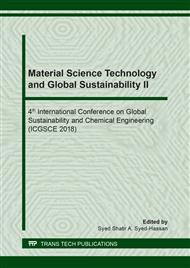[1]
Leontaritis, K., Offshore asphaltene and wax deposition: Problems/solutions. Vol. 217. (1996).
Google Scholar
[2]
Wu, Y., et al., Modified Maleic Anhydride Co-polymers as Pour-Point Depressants and Their Effects on Waxy Crude Oil Rheology. Energy & Fuels, 2012. 26(2): pp.995-1001.
DOI: 10.1021/ef201444b
Google Scholar
[3]
Chen, S., G. Øye, and J. Sjöblom, Rheological Properties of Model and Crude Oil Systems when Wax Precipitate under Quiescent and Flowing Conditions. Journal of Dispersion Science and Technology, 2007. 28(7): pp.1020-1029.
DOI: 10.1080/01932690701522525
Google Scholar
[4]
Wang, F., et al., The effect of nanohybrid materials on the pour-point and viscosity depressing of waxy crude oil. Chinese Science Bulletin, 2011. 56(1): pp.14-17.
DOI: 10.1007/s11434-010-4174-4
Google Scholar
[5]
Taborda Acevedo, E.A., Viscosity reduction of heavy crude oil through the addition of nanofluids on the non-thermal process. 2017, Universidad Nacional de Colombia-Sede Medellín.
Google Scholar
[6]
Amanullah, M. and A.M. Al-Tahini, Nano-Technology - Its Significance in Smart Fluid Development for Oil and Gas Field Application, in SPE Saudi Arabia Section Technical Symposium. 2009, Society of Petroleum Engineers: Al-Khobar, Saudi Arabia.
DOI: 10.2118/126102-ms
Google Scholar
[7]
Taborda, E.A., et al., Effect of nanoparticles/nanofluids on the rheology of heavy crude oil and its mobility on porous media at reservoir conditions. Fuel, 2016. 184: pp.222-232.
DOI: 10.1016/j.fuel.2016.07.013
Google Scholar
[8]
Aladag, B., et al., Experimental investigations of the viscosity of nanofluids at low temperatures. Applied Energy, 2012. 97: pp.876-880.
DOI: 10.1016/j.apenergy.2011.12.101
Google Scholar
[9]
Farzaneh, H., et al., Stability of nanofluids: Molecular dynamic approach and experimental study. Energy Conversion and Management, 2016. 111: pp.1-14.
Google Scholar
[10]
Ghosh, S.P., Synthesis and Characterization of Zinc Oxide Nanoparticles by Sol-Gel Process. (2012).
Google Scholar
[11]
Ba-Abbad, M.M., et al., The effect of process parameters on the size of ZnO nanoparticles synthesized via the sol–gel technique. Journal of Alloys and Compounds, 2013. 550(Supplement C): pp.63-70.
DOI: 10.1016/j.jallcom.2012.09.076
Google Scholar
[12]
Hasnidawani, J.N., et al., Synthesis of ZnO Nanostructures Using Sol-Gel Method. Procedia Chemistry, 2016. 19(Supplement C): pp.211-216.
DOI: 10.1016/j.proche.2016.03.095
Google Scholar
[13]
dos Santos, J.d.S.T., A.C. Fernandes, and M. Giulietti, Study of the paraffin deposit formation using the cold finger methodology for Brazilian crude oils. Journal of Petroleum Science and Engineering, 2004. 45(1): pp.47-60.
DOI: 10.1016/j.petrol.2004.05.003
Google Scholar
[14]
Bello, O.O., et al., An Evaluation of the Performance of Selected Wax Inhibitors on Paraffin Deposition of Nigerian Crude Oils. Petroleum Science and Technology, 2006. 24(2): pp.195-206.
DOI: 10.1081/lft-200044504
Google Scholar
[15]
Mizutani, N., et al., Effect of ferrous/ferric ions molar ratio on reaction mechanism for hydrothermal synthesis of magnetite nanoparticles. Bulletin of Materials Science, 2008. 31(5): pp.713-717.
DOI: 10.1007/s12034-008-0112-3
Google Scholar
[16]
Ba-Abbad, M.M., et al., The effect of process parameters on the size of ZnO nanoparticles synthesized via the sol–gel technique. Journal of Alloys and Compounds, 2013. 550: pp.63-70.
DOI: 10.1016/j.jallcom.2012.09.076
Google Scholar
[17]
Wahab, R., Y.-S. Kim, and H.-S. Shin, Synthesis, Characterization and Effect of pH Variation on Zinc Oxide Nanostructures. MATERIALS TRANSACTIONS, 2009. 50(8): pp.2092-2097.
DOI: 10.2320/matertrans.m2009099
Google Scholar
[18]
Bari, A., et al., Effect of solvents on the particle morphology of nanostructured ZnO. (2009).
Google Scholar
[19]
Nassar, N.N., et al., Development of a Population Balance Model to Describe the Influence of Shear and Nanoparticles on the Aggregation and Fragmentation of Asphaltene Aggregates. Industrial & Engineering Chemistry Research, 2015. 54(33): pp.8201-8211.
DOI: 10.1021/acs.iecr.5b02075
Google Scholar
[20]
Ghannam, M.T., et al., Rheological properties of heavy & light crude oil mixtures for improving flowability. Journal of Petroleum Science and Engineering, 2012. 81: pp.122-128.
DOI: 10.1016/j.petrol.2011.12.024
Google Scholar
[21]
Mortazavi-Manesh, S. and J.M. Shaw, Effect of Diluents on the Rheological Properties of Maya Crude Oil. Energy & Fuels, 2016. 30(2): pp.766-772.
DOI: 10.1021/acs.energyfuels.5b02367
Google Scholar
[22]
Argillier, J.F., et al., Influence of Asphaltenes Content and Dilution on Heavy Oil Rheology, in SPE International Thermal Operations and Heavy Oil Symposium. 2001, Society of Petroleum Engineers: Porlamar, Margarita Island, Venezuela.
DOI: 10.2118/69711-ms
Google Scholar
[23]
Bazyleva, A.B., et al., Bitumen and Heavy Oil Rheological Properties: Reconciliation with Viscosity Measurements. Journal of Chemical & Engineering Data, 2010. 55(3): pp.1389-1397.
DOI: 10.1021/je900562u
Google Scholar
[24]
Mortazavi-Manesh, S. and J.M. Shaw, Thixotropic Rheological Behavior of Maya Crude Oil. Energy & Fuels, 2014. 28(2): pp.972-979.
DOI: 10.1021/ef4022637
Google Scholar
[25]
Long, J., et al., Novel Solvent Deasphalting Process by Vacuum Residue Blending with Coal Tar. Industrial & Engineering Chemistry Research, 2011. 50(19): pp.11259-11269.
DOI: 10.1021/ie2004169
Google Scholar
[26]
Ridzuan, N., F. Adam, and Z. Yaacob, Molecular Recognition of Wax Inhibitor Through Pour Point Depressant Type Inhibitor, in International Petroleum Technology Conference. 2014, International Petroleum Technology Conference: Kuala Lumpur, Malaysia.
DOI: 10.2523/17883-ms
Google Scholar
[27]
Ridzuan, N., F. Adam, and Z. Yaacob, Evaluation of the inhibitor selection on wax deposition for Malaysian crude oil. Petroleum Science and Technology, 2016. 34(4): pp.366-371.
DOI: 10.1080/10916466.2015.1127971
Google Scholar


